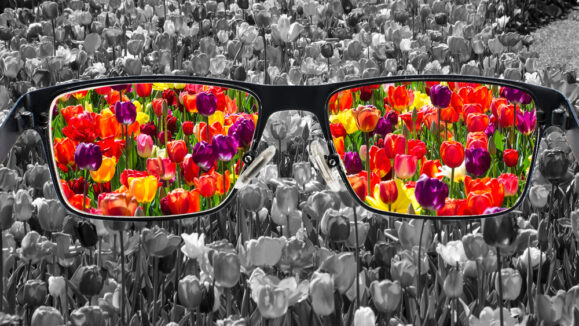The eye comes equipped with its own photosensitive protection: the cornea and the crystalline lens. They help to filter a lot of the UV light encountered in a regular environment; however, there are situations where extra protection is needed. For example, it takes a few minutes for our eyes to adjust to midafternoon sunshine after a couple of hours in a dark movie theater. Often people will reach for their sunglasses on their way out of the building to avoid that intense response to significant light increases.
However, many people with optical refractive errors can not simply put on their drug store shades or expensive sunglasses. Most spectacles are transparent to visible light and offer no extra protection. But with the development of photochromic lenses in the past decades, optometric patients now have several options that increase the eye’s ability to cope with light variations on a daily basis.
There have been many developments in photochromic lenses, from fashionable pink tinted glasses to UV resistant contact lenses. These lenses obviously provide a useful function considering their continued popularity. However, they did not initially capture the market. Just like with all new optical technology, there were many improvements and reimaginings along the way.
How it Started
The history of spectacles begins in the 10th century and there have been approximately 1.3 billion eyeglass-wearers since the initial invention.¹ There has been steady progress in the development and improvement of spectacles. Photochromic lenses were a great leap forward in the field of protective eyewear, combining style with practicality.
The trend toward photochromic lenses seems intuitive. In higher income countries, consumer trends tend towards convenience. Darkened lenses are already worn by most people when outside on a sunny day. Spectacle wearers have the option of having a pair of clear lenses and a pair of prescription sunglasses. For many though, obtaining and carrying two pairs of lenses — if they plan on moving from low light to intense light situations — is a burden. Photochromic lenses offer an alternative.
How They’re Made and Who Makes Them
Photochromic lenses were made commercially available as early as the 1960s. These lenses were made from glass and used silver halide crystals to provide a darkened appearance when activated. This also allowed the lenses to revert to a clear state once they were no longer activated. Plastic photochromic lenses, created using spiropyrans, spirooxazines and naphthopyrans, were then made available in the 1980s using a process in which spiroindoline photochromic dye was inserted between several coatings of polyurethane on the surface of polycarbonate lenses. This allowed for a uniform tint density across the lens.¹ Plastic photochromic lenses did not find commercial viability until the introduction of Transitions Lenses in 1990 from Transitions Optical (Florida, USA).
According to their patent, Transitions Lenses were intended to provide photochromic lenses with a relatively long user life while being commercially marketable, lightweight and comfortable. They also developed a method of imbibing the lenses with photochromic chemicals in a way that would allow them to be used by patients with various kinds of refractive errors — and thus, expanding the realm of photochromic lens possibility.
Transitions Optical has since been the leading company for photochromic lenses and they continue to develop and produce new innovations in specific light filtering. They are now developing, in partnership with Johnson & Johnson Vision (Florida, USA), ACUVUE® OASYS with Transitions™. These are contact lenses with photochromic technology. This expands the total market and shows the ever-evolving world of optics, refractive treatments and ocular safety.
Benefits and Drawbacks
The human eye has struggled to adapt to certain levels of increased illumination. Though the eye has some built in functions that respond to increases and decreases in light, the eye still requires extra protections in certain environments. Sunglasses have been used for decades as eye protection and they have been made fashionable by Hollywood stars like Marylin Monroe and Audrey Hepburn. They are in themselves a statement of independence, worn by spies and socialites alike.
Naturally, individuals who are being treated for refractive errors also want to be fashionable while protecting their eyesight — and clear lenses aren’t always enough. Therefore, adding filtering via a photochromic lens significantly increases subjects’ abilities to cope with intense broadband and shortwave lighting conditions and to adapt back to normal.² Photochromic lenses are an answer to this need.
However, photochromic lenses do not function equally in all conditions. Each lens has an expiration date and can be affected by environmental factors. Researchers have studied the differences of photochromic lenses in warm and cold temperatures and found that “there are significant differences in the optical properties of the photochromic lenses in terms of an absorbance at a shorter wavelength, a lower transmittance, a higher optical density, optical blocking percentage ratio, and luminous transmittance at the cold as compared to the warm temperature.” They recommend that patients be informed of these potential limitations, such as increased fading rate variation that may occur in different environments.³ It may be necessary for the patient to use another form of refractory correction in the extreme cold, for example.
Despite some limitations, most wearers of photochromic lenses find them to be useful and are satisfied with their experience. The reason individuals tend to wear protective eyewear (sunglasses, photochromics) outdoors is likely driven, in part, by increased comfort and some measurable benefits to visual performance.¹ Photochromic lenses are popular for the same reasons that sunglasses are popular and there are now more alternatives for those with refractory conditions.
The Future
Photochromic lenses protect eyes from harmful light and may reduce the instances of sun exposure-related eye degeneration. On top of all that, they now come in hundreds of different styles. Transitions Optical has been joined by more companies around the globe, such as Corning Optical (North Carolina, USA) and Hoya Vision (Bangkok, Thailand), to produce innovation in photochromic technology. With these companies’ improvements and new products, the future looks bright … and there is no need to worry if you have your photochromic lenses.
References
- Pillay R, Hansraj R, Rampersad N. Historical Development, Applications and Advances in Materials Used in Spectacle Lenses and Contact Lenses. Clin Optom (Auckl). 2020;12:157-167.
- Renzi-Hammond LM, Hammond BR Jr. The effects of photochromic lenses on visual performance. Clin Exp Optom. 2016;99(6):568-574.
- Moon BY, Kim SY, Yu DS. Differences in the optical properties of photochromic lenses between cold and warm temperatures. PLoS One. 2020;15(5): e0234066.



